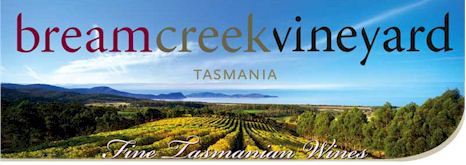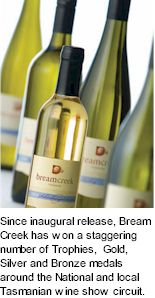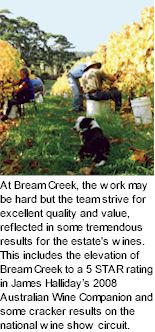


The original consortium in 1973 planted 5 hectare of vines consisting mainly of Riesling and Cabernet Sauvignon, with some Pinot Noir, Chardonnay and Gewurztraminer. In August 1990, the vineyard was purchased by Fred Peacock - one of Tasmania’s leading viticulturalists. Fred’s priority was to increase Pinot Noir plantings and introduce Sauvignon Blanc and Schonburger (the first commercial plantings in the Southern Hemisphere.) The Riesling vines are now over 30 years old, some of the oldest commercial vines in Tasmania. With Fred’s dedication and passion, the vineyard is now a 7.5 hectare showcase of premium Tasmanian varieties.

Marion Bay is steeped with history. The vineyard overlooks where Abel Tasman first landed in 1642, raised the Dutch flag and went ashore to also collect water. Later in 1772 French Navigator Marion du Fresne anchored his ships Mascarin and Castries in what is now known as Marion Bay. Today, the Bream Creek district is a rural area with a small thriving coastal community- well known for its artisans- painters, sculptors, fine furniture makers, jewellers and potters. Central to this inspired environment, Bream Creek Vineyard is an integral part of this mosaic as a unique, quality focused premium wine producer.
Bream Creek Vineyard is planted on a north-east ridge above Marion Bay on the edge of the Tasman Sea. This gently sloping site, coastal location and maritime influence, result in growing conditions that are characterised by long mild seasons to create premium fruit quality. The vineyard enjoys a cool frost free spring, long sunny summer days with sea breezes and an extended autumn ripening period. Surrounded by neighbouring forest and windbreaks, the vineyard is nicely sheltered from strong and cold winds.
Soils are deep and range from brown to black clay loams with a little small stone on the higher ground. Particular attention has been made to match varieties to the different range of soil types within the vineyard. The site features a large dam which is used sparingly for trickle irrigation. All vines are vertical-shoot positioned and trained. They are also hand pruned and picked. Crop yields are very modest with both small berries and quite small bunches. This allows low yields of exceptional cool climate fruit with enhanced varietal characters – perfect for winemaking and the production of truly premium cool climate wines.

Bream Creek wines are hand-crafted to capitalise on the stunning flavours that originate from predominantly old vines. The wines (both red and white) are made to age. Aromatic whites are generally whole-bunch pressed with skin contact creating balance and good structure. Chardonnay goes through partial malolactic fermentation and lees-stirring to create texture and elegance.
The red varieties, particularly Pinot Noir are created utilising traditional methods and on some occasions wild ferments. Wines are matured in carefully selected new and aged French oak. These methods retain delicate flavours with multiple dimensions, palate weight and structure. After years of deliberation at Bream Creek the estate released a Reserve Pinot Noir and it was a stand out from day one! Already a multiple trophy and gold medal winner, 2005 produced near perfect conditions for flowering, fruit-set and ripening. The bouquet is exquisite, and palate shows true finesse.
Bream Creek may be the only producer of the Schonburger style of wine in the southern hemisphere. For those who really enjoy their desert wines, this is one that is definitely on the agenda. The best way to describe this wine is luscious! It has alluring floral and honeysuckle blossom characters mingled with tantalising mandarin peel and apricot aromas. The palate is well balanced, rich and flavoursome, but with a clean snappy finish, particularly enjoyable with blue vein cheese or sticky date pudding.
When working away in the vineyard, the spectacular coastal location never ceases to amaze the Bream Creek winemaking team. This beautiful part of the world and the diligence of the viticulture continues to produce some classic cool climate wines. To complement the estate's 35 year old Riesling vines (the oldest commercially planted in Tasmania) more plantings were established. The result of a very strong demand for Bream Creek's spectacular Rieslings and the great suitability of this variety to a vey unique terroir!
